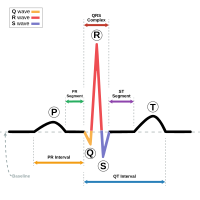
Photo from wikipedia
Objective Historically, electrocardiographic (ECG) interpretation criteria for athletes were only applicable to adults. New international recommendations now account for athletes ≤16 years, but their clinical appropriateness is unknown. We sought… Click to show full abstract
Objective Historically, electrocardiographic (ECG) interpretation criteria for athletes were only applicable to adults. New international recommendations now account for athletes ≤16 years, but their clinical appropriateness is unknown. We sought to establish the diagnostic accuracy of new international ECG recommendations against the Seattle criteria and 2010 European Society of Cardiology (ESC) recommendations in paediatric athletes using receiver operator curve analysis. Clinical context was calculated using Bayesian analysis. Methods 876 Arab and 428 black male paediatric athletes (11–18 years) were evaluated by medical questionnaire, physical examination, ECG and echocardiographic assessment. ECGs were retrospectively analysed according to the three criteria. Results Thirteen (1.0%) athletes were diagnosed with cardiac pathology that may predispose to sudden cardiac arrest/death (SCA/D) (8 (0.9%) Arab and (5 (1.2%) black)). Diagnostic accuracy was poor (0.68, 95% CI 0.54 to 0.82) for 2010 ESC recommendations, fair (0.70, 95% CI 0.54 to 0.85) for Seattle criteria and fair (0.77, 95% CI 0.61 to 0.93) for international recommendations. False-positive rates were 41.0% for 2010 ESC recommendations, 21.8% for Seattle criteria and 6.8% for international recommendations. International recommendations provided a positive (+LR) and negative (−LR) post-test likelihood ratio of 9.0 (95% CI 5.1 to 13.1) and 0.4 (95% CI 0.2 to 0.7), respectively. Conclusion In Arab and black male paediatric athletes, new international recommendations outperform both the Seattle criteria and 2010 ESC recommendations, reducing false positive rates, while yielding a ‘fair’ diagnostic accuracy for cardiac pathology that may predispose to SCA/D. In clinical context, the ‘chance’ of detecting cardiac pathology within a paediatric male athlete with a positive ECG (+LR=9.0) was 8.3%, whereas a negative ECG (−LR=0.4) was 0.4%.
Journal Title: Heart
Year Published: 2018
Link to full text (if available)
Share on Social Media: Sign Up to like & get
recommendations!